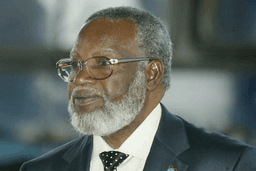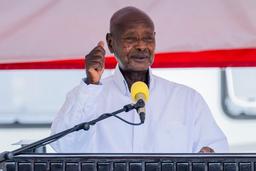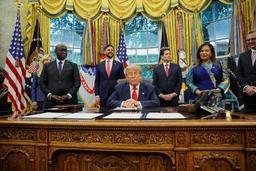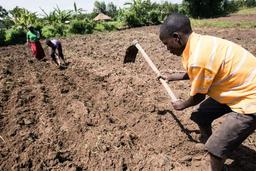Liberia
Liberia is a country located on the West African coast. Founded in 1822 by freed American and Caribbean slaves under the auspices of the American Colonization Society, it declared independence in 1847. Liberia is Africa’s oldest republic and the first African country to elect a female president. Despite its historical significance, the country has faced civil wars, economic hardship, and public health crises, notably the Ebola outbreak in 2014–2016.


5.5 million people

Africa (West Africa)

111,369 square kilometers (about 43,000 square miles)

GMT (UTC +0)

English, Kpelle, Bassa, Grebo, Kru, Lorma, Gio, Mano, and others

Liberian Dollar (LRD)

Christianity: ~85%, Islam: ~12%, Traditional African religions and others: ~3%

President: Joseph Boakai (as of January 2024)
Brief
Liberia is a country located on the west coast of Africa, bordered by Sierra Leone, Guinea, Côte d'Ivoire, and the Atlantic Ocean. It holds the distinction of being Africa’s first and oldest modern republic, founded in 1847 by freed African American and Caribbean slaves with support from the American Colonization Society. Its capital, Monrovia, is named after U.S. President James Monroe.
Liberia’s history is marked by its unique foundation, a prolonged civil war (1989–2003), and recent rebuilding efforts. Despite facing challenges such as poverty and infrastructural damage, Liberia continues to progress through democratic governance, natural resource development, and international partnerships. English is the official language, and the country is home to a rich mix of ethnic groups and traditional cultures.
Cultural Life
Liberia’s cultural life is a rich tapestry shaped by its indigenous traditions and the influences of freed African American slaves who settled in the country in the 19th century. The result is a unique blend of African heritage and Western customs that define the nation’s identity.
At the heart of Liberian culture are its ethnic groups, including the Kpelle, Bassa, Gio, Kru, and others, each with distinct languages, customs, and social practices. These groups contribute vibrant oral traditions, music, dance, and rituals to the national cultural scene. The Americo-Liberians—descendants of freed African Americans—introduced Western-style dress, Christianity, and forms of governance that co-exist with traditional African practices.
Liberian society values community life, extended family networks, and mutual support systems. Social events such as weddings, funerals, and initiation rites are central to community life and often involve elaborate ceremonies, music, and feasting. Respect for elders and communal cooperation remain important social values.
Music and dance are vital expressions of Liberian identity, with genres like Gbema and Hipco blending traditional rhythms and contemporary themes. Handcrafted arts, including woodcarvings, masks, and woven textiles, reflect deep spiritual and cultural meanings. Storytelling, proverbs, and folk tales remain central to passing down wisdom and preserving heritage.
Liberia’s cultural life continues to evolve, balancing its diverse indigenous roots with global influences, yet it remains deeply anchored in traditions that celebrate identity, resilience, and communal harmony.
Daily Life and Social customs
Daily life in Liberia is shaped by a combination of cultural traditions, economic conditions, and the natural environment. Most Liberians begin their day early, especially in rural areas where farming is the primary livelihood. Men, women, and even children often work in the fields, cultivating crops like rice, cassava, and palm oil. In urban centers like Monrovia, people head to offices, markets, or construction sites depending on their occupation. Street vendors are also a common sight, selling everything from food and clothes to phone credit and household items.
Family and community play a central role in Liberian society. It’s common for extended families to live together or nearby, and neighbors often help each other with daily chores or childcare. Meals are typically shared, with rice being the staple food served with soup made from vegetables, fish, or meat. Women usually take on the responsibility of cooking and maintaining the household, while also contributing economically through small-scale trade or farming.
Education is valued, but access remains uneven, especially in rural areas. Children who attend school often walk long distances, and many schools lack sufficient resources. Despite these challenges, many families are determined to provide their children with an education, seeing it as a path to a better future. Religious life also plays an important part in daily routines, with many Liberians attending church or mosque regularly and participating in faith-based community events.
In the evenings, people gather to relax, share stories, and listen to music or the radio. Electricity can be unreliable, so many homes rely on generators or solar panels. Life in Liberia is not without its difficulties—such as poverty, limited infrastructure, and health care—but the people remain resilient, community-oriented, and hopeful. Their strong cultural identity and sense of togetherness continue to shape their way of life.
Photos




Cuisine
Liberian cuisine is a flavorful reflection of the country’s culture, history, and natural resources. Heavily influenced by West African traditions, local dishes are rich in spices and often made with locally grown ingredients such as rice, cassava, plantains, and palm oil. Rice is the staple food and is typically served with a variety of soups and stews.
A popular dish is palm butter soup, made from the pulp of palm nuts and often cooked with fish, meat, or chicken. Another common meal is cassava leaves, which are ground and simmered with palm oil, pepper, meat, and seasoning cubes. Jollof rice, though shared across West Africa, is also a favorite in Liberia, known for its spicy tomato-based flavor and colorful mix of vegetables and proteins.
Street food is an important part of everyday life. Items like fried plantains, roasted corn, and “kala” (fried dough balls) are commonly sold in markets and on busy streets. Liberians also enjoy spicy pepper sauces and season their food with ingredients like smoked fish, onions, and hot peppers to add depth and heat.
Food in Liberia is more than just sustenance—it’s a social and cultural experience. Meals are often shared among family and friends, especially during celebrations and traditional gatherings. Despite economic challenges, Liberian cuisine remains a source of pride, offering warmth, flavor, and a strong sense of identity.

Cuisines




Music
Liberian music is a vibrant blend of traditional rhythms and modern influences, reflecting the country’s diverse ethnic groups and cultural heritage. Traditional music features drums, call-and-response vocals, and instruments like the balafon and talking drum, often played during ceremonies, festivals, and storytelling. In urban areas, contemporary genres such as Hipco—a Liberian form of hip-hop with lyrics in local dialects—are popular among youth. Gospel music also plays a major role in daily life, reflecting the country’s deep religious roots. Whether traditional or modern, music in Liberia serves as a powerful form of expression, community bonding, and national pride.


Arts
Liberian art is deeply rooted in tradition, with a focus on storytelling, spirituality, and community identity. It includes woodcarving, mask-making, weaving, pottery, and textile design, often created by hand and passed down through generations. Masks and sculptures play significant roles in cultural ceremonies and are used by secret societies like the Poro and Sande. Contemporary Liberian artists also explore painting and mixed media, blending traditional themes with modern issues. Whether traditional or modern, Liberian art reflects the resilience, creativity, and rich cultural heritage of its people.

Photos




People
Ethnic Groups
Liberia is home to a rich mosaic of ethnic groups, each with its own language, customs, and traditions. There are over 16 major indigenous ethnic groups, with the largest being the Kpelle, primarily located in central Liberia. Other major groups include the Bassa, Gio (Dan), Mano, Krahn, Grebo, Vai, Gola, Kru, and Lorma. These groups are generally associated with specific geographic regions and play key roles in shaping local identities and cultural practices.
In addition to indigenous groups, there is also a small population of Americo-Liberians, descendants of freed African Americans who settled in Liberia during the 19th century. Though historically influential, especially in politics and education, they make up a small percentage of the total population today.
Ethnic diversity in Liberia has contributed to a vibrant cultural landscape, but it has also been a factor in past political tensions. Nonetheless, many Liberians today embrace inter-ethnic coexistence and national unity while preserving their unique cultural heritages.

Ethnic groups




Religion
Religion in Liberia is a vital part of daily life and national identity. The majority of Liberians are Christians, with various denominations such as Methodist, Baptist, and Pentecostal widely practiced. Islam is also significant, especially in the northern and western regions, and is followed by a sizable portion of the population. Traditional African beliefs, often centered around ancestral spirits and nature, are still practiced and sometimes blended with Christianity or Islam. Religious gatherings are common and serve as important social events, with churches and mosques playing key roles in community life, education, and moral guidance.

Settlement Patterns
Settlement patterns in Liberia are shaped by geography, history, and economic activities. Most of the population is concentrated along the coast and in urban areas, especially in and around the capital city, Monrovia. Coastal settlements developed due to access to trade routes and ports, while inland areas are more rural and sparsely populated. Villages and towns in the interior are often organized around farming communities, with homes clustered near water sources and fertile land. Traditional settlements typically feature thatched-roof houses made from mud or wood, while urban areas have more modern structures. Over time, migration from rural to urban areas has increased, driven by the search for jobs, education, and better services, leading to the rapid growth of cities and the expansion of informal settlements.



Demographic Trends
Liberia’s population in mid‑2025 was approximately 5.73 million, growing at an annual rate of about 2.1 % . Over half of its people (around 55 %) now live in urban areas, a shift driven by ongoing internal migration and rapid urban expansion around Monrovia and others.
The country has a very young population—the median age is just 18.8 years in 2025, and more than 40 % are under 15 years of age (ages 0–17) account for around three‑quarters of all residents, meaning Liberia faces an exceedingly high youth dependency ratio close to 74 percent. This demographic structure places pressure on social services like education, healthcare, and employment.
With a total fertility rate (TFR) of around 3.8 to 4.2 children per woman, Liberia continues to see relatively high birth rates, although they’ve begun a gradual decline in recent years. Despite improvements in child health, infant mortality remains high—roughly 54–56 deaths per 1,000 live births—and maternal mortality remains among the highest globally, with rates around 650 per 100,000 live birth.
Urbanization is proceeding at a steady ~3 % per year, fueling growth in Monrovia—which houses over a third of the nation’s population and its expanding metro region houses more than 2.2 million people. This expansion is stretching infrastructure and public services, particularly in housing, water access, and healthcare, highlighting persistent rural–urban inequality in service delivery.
Liberia is experiencing rapid population growth, significant urbanization, and a youth-dominated age structure. These dynamics offer both a potential demographic dividend and major policy challenges—particularly in education, employment, healthcare, and urban planning—to harness this young, growing population for sustainable development.

Touristic Cities
Monrovia – The Capital City
Monrovia, the capital and largest city of Liberia, is the country’s political, economic, and cultural hub. Located on the Atlantic coast at the mouth of the Mesurado River, it was founded in 1822 by freed African Americans from the United States and named after U.S. President James Monroe. As a historic settlement of the Americo-Liberians, it holds deep symbolic importance in the nation’s identity.

Beyond Monrovia, Liberia has several important cities that contribute to its regional development and cultural diversity. Gbarnga, located in central Liberia, is a key commercial and administrative center in Bong County and is known for its role in education and agriculture. Buchanan, the second-largest port city, lies on the coast in Grand Bassa County and serves as a hub for the export of iron ore and timber.
In the north, Ganta is a rapidly growing trade city near the Guinean border, known for its cross-border commerce and vibrant markets. Zwedru, the main city in southeastern Liberia, is the heart of Grand Gedeh County and a center for forestry and trade. Harper, in the far southeast, is a historic coastal town with colonial-era architecture and ties to Liberia’s early settlers.
Other notable cities include Kakata, a center for rubber production and teacher training, and Voinjama, the capital of Lofa County, known for its cultural richness and proximity to Sierra Leone and Guinea. Each city plays a unique role in Liberia’s economy and identity, reflecting the country’s geographic and ethnic diversity.
Photos



Accommodations
Guesthouses
Guesthouses in Liberia are widely available, especially in Monrovia and other major towns like Gbarnga, Buchanan, and Robertsport. These establishments are generally affordable and offer a cozy, homelike atmosphere. Most guesthouses provide basic amenities such as private or shared rooms, local meals, and Wi-Fi access. They are popular among backpackers, aid workers, and travelers seeking extended stays. Many guesthouses also reflect local culture in their design and hospitality, giving guests a more personal experience.




Hotels and Resorts
Liberia has a growing hotel industry, particularly in the capital city, Monrovia. Hotels range from luxurious international-standard facilities to smaller, budget-friendly options. Prominent hotels like the Royal Grand Hotel and Mamba Point Hotel cater to business travelers, diplomats, and tourists with services like fine dining, conference rooms, fitness centers, and secure premises. In smaller towns and along the coast, mid-range hotels provide comfortable accommodations, though with fewer amenities. The hotel sector continues to expand, supported by the tourism and business sectors.



Campings
Camping in Liberia is an emerging activity, especially in nature-rich areas such as Sapo National Park, Robertsport, and coastal regions along the Atlantic. While formal campsites are limited, adventurous travelers often camp on beaches or within eco-tourism zones, sometimes with the assistance of local tour operators. Facilities vary widely, from simple tent setups to eco-lodges offering guided nature experiences. For safety and convenience, travelers are advised to camp with knowledgeable guides and in designated areas.




Requirement for visa
Documents needed when applying for a visa
If you're planning to travel to Liberia, you must apply for a visa (unless you're from one of the ECOWAS countries, which generally enjoy visa-free access). Below are the typical documents required when applying for a Liberian visa through a Liberian embassy, consulate, or online (if e-visa services are available in your country).
Basic Visa Application Requirements:
1. Completed Visa Application Form
- Obtainable from the Liberian embassy/consulate or official website.
- Must be filled out accurately and signed.
2. Valid Passport
- Must be valid for at least 6 months beyond the intended date of entry.
- At least two blank pages for the visa stamp.
3. Passport-Sized Photographs
- Typically two recent color photos.
- Must meet standard photo requirements (white background, no headgear unless for religious reasons).
4. Travel Itinerary or Flight Booking
- A copy of your round-trip ticket or flight reservation.
- Confirming entry and exit dates from Liberia.
5. Hotel Reservation or Invitation Letter
- If staying at a hotel: Confirmed booking is required.
- If staying with a host: Invitation letter from the host in Liberia, including:
- Host’s full name and contact information
- Address in Liberia
- Relationship to the applicant
- Duration and purpose of stay
6. Proof of Financial Means
- Bank statements, employment letter, or other documents showing you can financially support yourself during your stay.
7. Yellow Fever Vaccination Certificate
- Mandatory for entry into Liberia.
- Must be presented along with your visa application and at the port of entry.
8. Visa Fee
- Payment amount varies depending on:
- Visa type (single or multiple entry)
- Duration of stay
- Nationality of the applicant
- Fees are typically paid in US Dollars, by bank transfer, money order, or direct deposit (depending on embassy instructions).
Additional Requirements (May Apply):
- Police clearance certificate – sometimes required for long-stay or work visas.
- Employment or business letter – if traveling for work or business.
- Student letter/admission – for student visas.
- Transit visas – may require proof of onward travel and a visa for the next destination.
Where to Apply:
- At the nearest Liberian embassy or consulate.
- Some locations may offer e-visa or visa-on-arrival services, but it's best to check in advance.
Economy of Liberia
1. Agriculture – Mainstay of the economy
Agriculture is the backbone of Liberia’s economy, employing about 70% of the population and contributing significantly to food security and rural livelihoods. The sector is dominated by smallholder farming, with most farmers practicing subsistence agriculture using traditional methods. Major food crops include rice, cassava, maize, and vegetables, while cash crops like rubber, palm oil, cocoa, and coffee are vital for export. Despite its importance, the sector faces challenges such as poor infrastructure, limited access to modern tools, and vulnerability to climate change. However, agriculture holds great potential for economic growth if supported by investment, improved technology, and better market access.

Mining and Natural Resources,Liberia is rich in:Iron ore – Historically one of its top exports,Gold and diamonds –Extracted mainly by small-scale and foreign companies.The mining sector has attracted foreign direct investment, particularly from China, India, and Western firms.Mining revenues are essential to the national budget but are vulnerable to global price shifts.

Forestry is a vital sector in Liberia’s economy, with extensive tropical rainforests covering much of the country. The industry centers on timber production, including valuable hardwoods like mahogany and teak, which are exported internationally. However, forestry in Liberia faces challenges such as illegal logging, deforestation, and the need for sustainable management practices. The government, along with international partners, has worked to improve regulation and promote responsible forestry to balance economic benefits with environmental conservation and community livelihoods.

Trade in Liberia is a crucial part of the economy, heavily reliant on the export of natural resources such as rubber, timber, iron ore, and palm oil. The country imports a wide range of goods including machinery, fuel, foodstuffs, and manufactured products, mainly from countries like China, the United States, and regional neighbors. Liberia benefits from trade agreements under the Economic Community of West African States (ECOWAS) and the African Continental Free Trade Area (AfCFTA), which facilitate regional trade. Despite infrastructure challenges and occasional trade imbalances, ongoing efforts to improve port facilities and diversify exports aim to strengthen Liberia’s trade capacity and integration into global markets

Transportation and Telecommunication
Liberia’s transport sector includes approximately 243 km of railways, over 10,600 km of roads (only about 657 km paved), four major seaports, and 29 airports, with only two paved runways.
Road travel is the dominant mode of land transport. Buses and taxis operate primarily around Monrovia, supported by the Monrovia Transit Authority (MTA) under the National Transit Authority, which has been revitalizing city bus services since the civil war, Long-distance travel largely relies on unpaved roads, which suffer from poor maintenance, especially during the rainy season, making rural mobility difficult
Liberia’s rail system—historically built for mining—comprises the Bong Mine Railway and the ArcelorMittal (LAMCO) line from Yekepa to Buchanan. Currently it transports only a fraction of its capacity and is subject to monopoly concerns, though government efforts aim to reform it into a multiuser system to better support commerce.
Sea lanes and ports play a strategic role: the Freeport of Monrovia is the flagship facility, and there are other functional ports in Buchanan, Harper, and Greenville. Future plans include expanding inland dry ports and upgrading port infrastructure to support regional trade.
Air transport is anchored by Roberts International Airport, which underwent major renovations completed by 2019—upgrading runways, terminals, and safety systems. The smaller Spriggs‑Payne Airport in Monrovia handles domestic and limited international flights. Smaller airports like Lamco Airport in Buchanan serve regional destinations.
On the telecommunications front, Liberia has two strong GSM operators—Lonestar Cell MTN and Orange Liberia—with mobile, voice, SMS, and 3G/4G data services. In 2022, there were around 3.7 million mobile connections in a population of about 5.2 million, though many users maintain multiple SIMs. Internet penetration was about 22% in early 2022.
High-speed internet is being expanded through fiber by LTC Mobile (formerly Libtelco) and private ISPs like Telecel Liberia, offering fiber-to-the-home and enterprise options in Monrovia and nearby areas. The government collaborates with international partners on projects like the ACE submarine cable and the Amilcar Cabral Submarine Cable, aiming to boost bandwidth, redundancy, and broader connectivity.Rural coverage is improving via partnerships such as between Nokia and iSAT Africa, which is deploying rural network infrastructure at approximately 200 sites to reduce the digital divide.
Despite this growth, challenges remain: limited paved roads, inconsistent rail access, high costs for internet, frequent power outages, and prohibitive infrastructure costs combine to limit quality and reach of both transport and telecom services.







Latest News in Liberia
Politics
The first president of independent Namibia, Sam Nujoma, has died at the age of 95 in the capital Windhoek, the country's current leader has announced.
Politics
Ugandan President Yoweri Museveni has officially announced his intention to seek re-election in the 2026 presidential race, extending his nearly four-decade rule. Museveni, who has been in power since 1986, is once again positioning himself as the steady hand guiding Uganda through challenges. His decision has sparked mixed reactions, with supporters praising his leadership and longevity, while critics call for fresh leadership and political reform. As the nation looks ahead to the 2026 elections, Uganda braces for a heated political contest.
Politics
Peace Agreement with DRC Rwanda and the Democratic Republic of Congo (DRC) signed a U.S.-brokered peace deal aimed at ending conflict and promoting regional trade. Rwanda agreed to stop supporting armed groups like M23 rebels, though it denies involvement. Tensions remain, and President Kagame is cautious about whether the peace will last.
Wildlife
Tanzania has announced that all foreign tourists visiting Mainland Tanzania will be required to purchase a mandatory travel insurance policy upon arrival, beginning January 2026. The new regulation, issued by the Ministry of Finance on July 4, 2025, is part of the government reforms in the country’s 2025/26 financial year agenda. According to the notice, the measure will apply to all non-citizens, with the exception of visitors from countries that are part of the East African Community (EAC) and the Southern African Development Community (SADC). Citizens from these regions will continue to be exempt from the requirement.
Environment
In light of the growing food insecurity crisis across many African nations, heads of state and agriculture experts gathered in Nairobi, Kenya, this week to discuss solutions to address food shortages, especially in regions severely affected by climate change, political instability, and economic challenges. The two-day summit, titled “Agriculture and Climate Resilience: A Pan-African Strategy”, brought together government officials, NGOs, scientists, and international organizations to create a comprehensive strategy to improve agriculture, nutrition, and sustainable food systems across the continent.
Tech & Science
In 2025, Artificial Intelligence (AI) isn’t just a futuristic buzzword - it’s the secret weapon behind some of the world’s most successful content creators. From bloggers and YouTubers to podcasters and marketers, AI-powered tools are changing the way we brainstorm, write, design, and edit. If you've ever struggled with writer’s block, lacked design skills, or wished for faster content creation - AI might be your best assistant yet. Here’s how AI is revolutionizing the creative industry and how you can use it to boost your projects.





